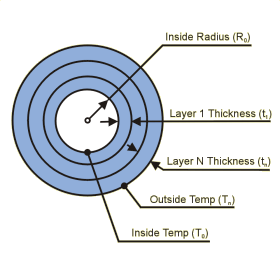This page calculates the exterior wall temperature (Tn) for an isothermal (constant temperature) multilayer cylinder. You must define the heat load (Q) conducted from the interior to the exterior layers as well as the temperature of the interior wall (T0) . The temperature on the exterior cylinder face is calculated. For each layer you must define the layer thickness (ti) as well as the layer conductivity ki.

The temperature (Tn) is calculated as:

Where T0 is the inner surface temperature, Q is the heat flow (positive heat flow is from T0 to Tn), ri is the outer radius of the layer i, ri-1 is the inner radius of the layer i, ki is the thermal conductivity of layer i, and L is the length of the cylinder. The end walls of the cylinder are assumed adiabatic. That is, only radial heat flow is accounted for.
Positive values of heat (Q) result in T0 being hotter than Tn. Negative values of heat (Q) result in T0 being cooler than Tn.
References
Holman, J.P., Heat Transfer, 7th ed., McGraw Hill Book Company, New York, 1990, p 30-32.